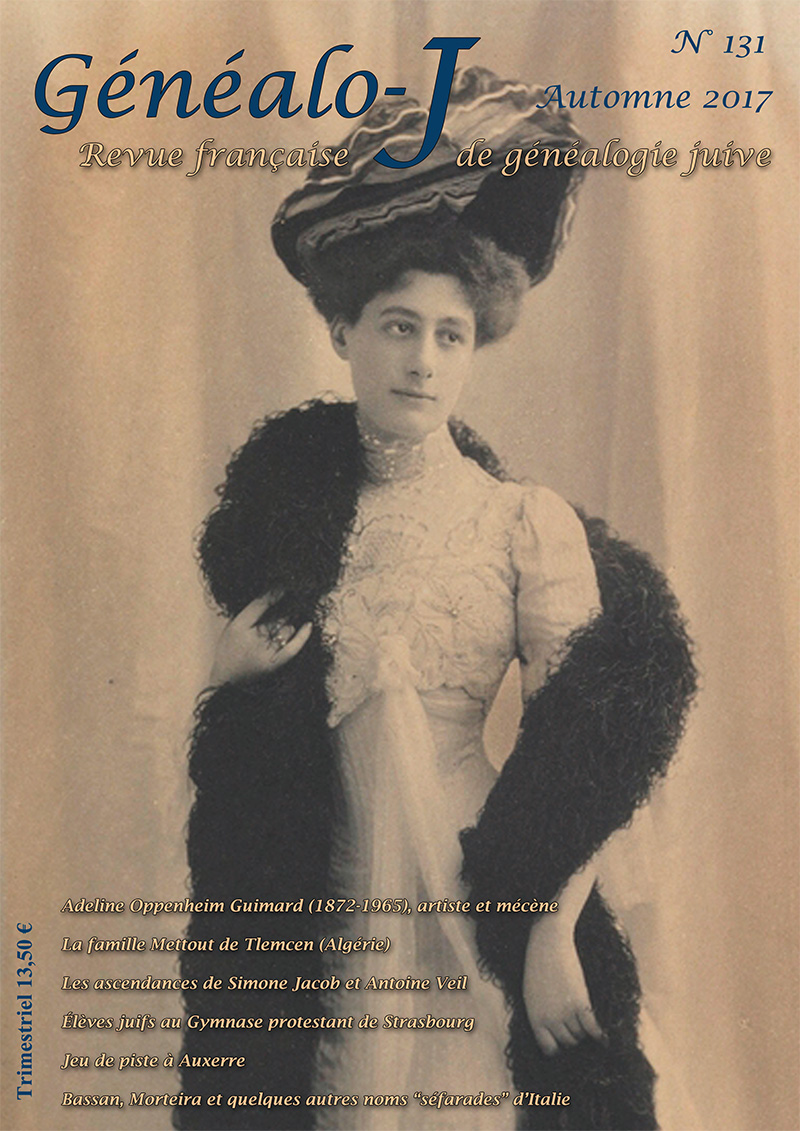
ABSTRACTS
Bruno Montamat
Adeline Oppenheim Guimard (1872-1965), artist and patron
The artist Adeline Oppenheim (1872-1965) was only briefly mentioned in the studies devoted to her husband the 'Art nouveau' architect Hector Guimard (1867-1942). Yet the life and personality of a Jewish American woman painter in the Paris of the 'Belle Epoque' and then of the interwar period allows to shed new light on the intimacy of this singular architect and the evolution of the status of woman in the early 20th century. By this late marriage and in parallel with her own artistic career Adeline Oppenheim Guimard fervently supported her husband's aesthetic research. As a duty of remembrance she bestowed after WWII most of the works she owned to French and American museums. This was her final tribute as she had wanted by their union to 'make their life a work of art'. Article followed by a genealogy of the Oppenheim family.
Roger Mettout
The Mettout family of Tlemcen (Algeria)
The oldest ancestor of this family that I found in a list of rabbis of Algeria published by an Israeli site is Yaakov ben Moshe.He was born in 1690 and died in Tlemcen in 1760. About its origin there are two hypotheses : Judaised Berbers or a Spanish family. Samual ben Saadia Motot, philosopher kabbalist and translator, lived in Guadalajara in the 14th century and his son or grandson Simeon was a famous mathematician in the 15th century.May be the latter left Spain for Morocco following the expulsion of the Jews in 1492. The surname was modified in the French civil records into Moutout, Moutot, Mattout, Mittout. But it remains linked to the town of Tlemcen alone. The genealogy of the family is the subject of this paper.
Pierre-André Meyer
Simone Jacob's et Antoine Veil's ascendancies
On the occasion of the death of Simone Veil (1927-2007) a survivor from Auschwitz, former minister, former President of the European Parliament, former President of the Foundation for the Memory of the Shoah, member of the Académie française, her ascendancy is traced back over six generations as well as that of her husband Antoine Veil (1926-2013) who will rest at her side in the Pantheon. A tribute to an exceptional personality who marked her time.
Françoise et Bernard Lyon-Caen
Jewish pupils in the Protestant Gymnasium of Strasbourg during the 19th century
Looking at the list of registration of the students in Jean Sturm Gymnasium in Strasbourg we tried to spot Jewish children. The first appears in year II of the Republic (1794-1795).We finally publish here a list of about 350 new pupils between 1795 and 1880 with the data we found about their families and the future of some of these children.
Anne-Marie Fribourg
Treasure hunt in Auxerre (in Bourgogne)
This article shows how one may be confronted with transcriptions of recorded names at the beginning of the 19th century quite different from the real names. This happened in places distant from the traditional locations of Jewish communities. This lead to cross-check data to reconstruct a family and find its origins and it involves the Felix family from Husseren (Alsace).
Alexander Beider
Bassan,Morteira and others Italian Sefarad family'names
In Jewish historiography Sefardim and Ashkenazim are often seen as totally separate groups. Yet a number of families have ancestors from both Spain and Germany. Italy represents the region where this type of melting pot worked. Numerous Ashkenazim migrated to Italy during the 14th-15th centuries. Sefardim arrived later. The first group appeared after the expulsion from Spain in 1492. The second group consisted of mainly Portuguese ex-crypto-Jews who arrived in the middle of the 16th century. In addition to these distinct cultural groups there were 'indigenous' Jews in Italy whose ancestors lived in the Apennine peninsula since the times of the Roman Empire as well as Jews expelled from France (14th century). The different Jewish communities of Italy gradually merged together. The paper discusses some of the most spectacular examples of the complexity of the origins of Italian Jews: the Basevi, Bassan, Castro, Morteira, Novara, and Porto families. These examples illustrate a general point: onomastics can provide valuable information to history and genealogy.